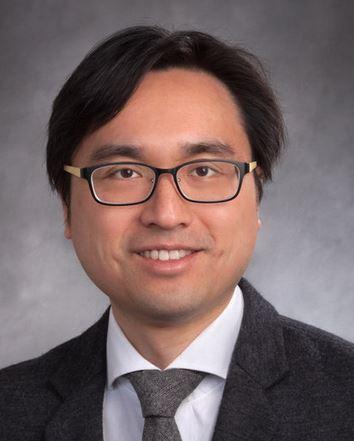
When Shih-Hsiu "Jerry" Wang, MD, PhD, joined the Duke/UNC Alzheimer’s Disease Research Center (ADRC) in 2021, he inherited oversight of more than 1000 preserved specimens of preserved brain tissue in the Bryan Brain Bank collected over the past 30 years. Since then, Wang has been working to make sure each of those specimens have been diagnosed and categorized correctly, while also maintaining his clinical duties in the Departments of Pathology and Neurology.
For our latest “Profiles in Brain Sciences” interview, Wang talks to us about his work helping to lead the Neuropathology Core of the Duke UNC ADRC. He also shares his hopes for a future with better treatments and biomarkers for Alzheimer’s disease, and how neuropathology has evolved since he entered the field. Finally, Wang shares his loves of time with family, attending museums, and visiting art galleries when he’s not at Duke.
What are your current responsibilities within the Departments of Pathology and Neurology? What does a typical day look like for you?
My clinical responsibilities include diagnoses of brain tumors, muscle and nerve biopsies, and brain autopsies. Additionally, I also direct the Bryan Brain Bank and Biorepository, now part of the Duke-UNC ADRC. In this role, I have been systematically reviewing and updating the diagnoses of the more than 1000 subjects in the brain bank. As we learn more about the pathology of Alzheimer’s disease and related dementias, the diagnostic criteria have changed quite a bit over the years.
With the help of Lab Manager John Ervin and Research Technician Erin Connolly, we have been performing more dissections and staining on these old cases to ensure that all our diagnoses and neuropathologic data meet the current diagnostic standards. I also serve as a contact person for investigators interested in our brain tissue collection, to ensure these valuable resources are utilized in the most efficient and rigorous way.
My days vary a lot, depending on what specific clinical responsibilities I have that week. Outside of my clinical work, I spend a lot of time communicating with collaborators and other investigators to plan and execute studies involving our human tissue collection.
How and when did you first become interested in neuropathology?
I’ve always been fascinated by the brain, particularly how the organization of neurons and other cell types give rise to complex function. Following a PhD in neuroscience, neuropathology seemed like a natural career choice.
In addition to your other duties, you and Carol Colton, PhD, also lead the Neuropathology Core of the Duke/UNC ADRC. What do these duties involve?
The brain bank constitutes a major part of the Neuropathology Core. But within the framework of the ADRC, there’s a lot more crosstalk between cores. For instance, we work with the clinical core to run the Autopsy and Brain Donation program, and the Data Management core for data sharing with other ADRC’s.
How has neuropathology changed the most since you started your career?
I think there’s a lot more integration of molecular diagnostics into our routine practice. This has mostly affected the diagnosis of brain tumors. For instance, many brain tumor entities nowadays are defined by the genetic mutations they carry, and some are even defined by the specific methylation (epigenetic) profile. I think as we learn more about neuromuscular and neurodegenerative diseases, there will also be more integration of different diagnostic modalities beyond histology and immunohistochemistry in these areas.
What potential developments in the field are you most excited to see in the next five to 10 years?
The most exciting developments in the next few years, I think, will be more effective treatment of Alzheimer’s disease and more reliable biomarkers for early diagnosis of Alzheimer’s and differential diagnosis from other entities.
What do you enjoy most about your work?
I enjoy the combination of clinical work and research. I also enjoy seeing new investigators reach out to us for neuropathology core resources.
What’s the hardest part of your job?
Balancing my clinical responsibilities with those associated with the neuropathology core, while developing my own research programs.
What other passions or hobbies do you have outside of Duke?
I enjoy spending time with my kids (3 and 8 years old), and attending concerts, art galleries, and museums.